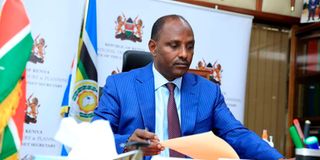Clear public debt or perish

Treasury Cabinet Secretary Ukur Yatani.
What you need to know:
- The government need to seek sustainable ways of minimising its expenditure to reduce the need for borrowing.
- The higher allocation to domestic borrowing might slow growth in the private sector lending.
The public debt requirement for the 2021/22 financial year is set to reduce by 4.2 per cent to Sh929.7 billion, from Sh970.9 billion in FY 2020/21, as per the revised budget. Debt servicing costs are set to rise by 22.1 per cent to Sh560.3 billion, from Sh458.7 billion in FY 2020/21.
Higher debt servicing costs may be attributable to the Debt Service Suspension Initiative (DSSI) agreement, which temporarily suspended Sh32.9 billion debt servicing costs in the last half of FY 2020/21.
Debt sustainability is still a key concern with public debt–to-GDP ratio having increased considerably over the past five years to 69.6 per cent as at last December. But the budget is expansionary as the government intends to spend more so as to steer the country out of the pandemic-driven economy.
Tax collection efficiencies
Kenya’s borrowing remains a major concern, going forward with its public debt burden of 69.6 per cent, compared to Uganda’s 49.8 per cent and Tanzania’s 27.1 per cent. The government need to seek sustainable ways of minimising its expenditure to reduce the need for borrowing and leverage the revenue-generating bases to service the existing debts.
The public debt mix is projected to comprise of 29.2 per cent foreign debt and 70.8 per cent domestic debt, from 44 per cent foreign and 56 per cent domestic as per FY 2020/21 budget. The higher allocation to domestic borrowing might slow growth in the private sector lending as banks opt to invest in government securities, which are viewed as low-risk and a stable source of returns.
It is, therefore, a tough balance and emphasis should be on stimulating the economy and increasing tax collection efficiencies.
Among other measures, the government should restructure the debt mix, going for more concessional borrowing to reduce debt servicing costs; limit commercial borrowing to development projects with high financial and economic returns; and ensure the more expensive debt is invested in projects that yield more than the market rate; and set up a Public Debt Management Authority (PDMA) to monitor all public debt-related transactions.
Mr Wamayuyi is an economic researcher. [email protected]





